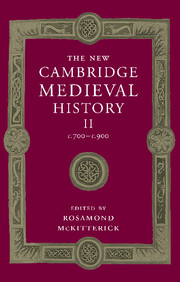Book contents
- Frontmatter
- PART I POLITICAL DEVELOPMENT
- 1 Introduction: sources and interpretation
- 2 The British Isles
- 3 Frankish Gaul to 814
- 4 The Frankish kingdoms, 814–898: the West
- 5 The Frankish Kingdoms, 817–911: the East and Middle Kingdoms
- 6 Fines Imperii: the Marches
- 7 The Vikings in Francia and Anglo-Saxon England to 911
- 8 Scandinavia, c. 700–1066
- 9 Slavs and Bulgars
- 10 The Muslims in Europe
- 11 Spain: the northern kingdoms and the Basques, 711–910
- 12 Lombard and Carolingian Italy
- 13 Byzantine Italy, c. 680–c. 876
- 14 Byzantium and the west, 700–900
- PART II GOVERNMENT AND INSTITUTIONS
- PART III CHURCH AND SOCIETY
- PART IV CULTURE AND INTELLECTUAL DEVELOPMENTS
- Conclusion
- Appendix genealogical tables
- List of primary sources
- Bibliography of secondary works arranged by chapter
- Index of manuscripts
- General index
- Frontispiece">
- Plate section
- Map 4 Charlemagne’s Europe and Byzantium, 814
- Map 19 The ecclesiastical provinces of western Europe 700-900
- Map 20 Carolingian schools, scriptoria and literary centres
- Genealogical table X: Wessex
- References
5 - The Frankish Kingdoms, 817–911: the East and Middle Kingdoms
from PART I - POLITICAL DEVELOPMENT
Published online by Cambridge University Press: 28 March 2008
- Frontmatter
- PART I POLITICAL DEVELOPMENT
- 1 Introduction: sources and interpretation
- 2 The British Isles
- 3 Frankish Gaul to 814
- 4 The Frankish kingdoms, 814–898: the West
- 5 The Frankish Kingdoms, 817–911: the East and Middle Kingdoms
- 6 Fines Imperii: the Marches
- 7 The Vikings in Francia and Anglo-Saxon England to 911
- 8 Scandinavia, c. 700–1066
- 9 Slavs and Bulgars
- 10 The Muslims in Europe
- 11 Spain: the northern kingdoms and the Basques, 711–910
- 12 Lombard and Carolingian Italy
- 13 Byzantine Italy, c. 680–c. 876
- 14 Byzantium and the west, 700–900
- PART II GOVERNMENT AND INSTITUTIONS
- PART III CHURCH AND SOCIETY
- PART IV CULTURE AND INTELLECTUAL DEVELOPMENTS
- Conclusion
- Appendix genealogical tables
- List of primary sources
- Bibliography of secondary works arranged by chapter
- Index of manuscripts
- General index
- Frontispiece">
- Plate section
- Map 4 Charlemagne’s Europe and Byzantium, 814
- Map 19 The ecclesiastical provinces of western Europe 700-900
- Map 20 Carolingian schools, scriptoria and literary centres
- Genealogical table X: Wessex
- References
Summary
louis the Pious had hurt himself, but his wounds were not worth talking about. Only three weeks later he was hunting again. Four months after this accident, the imperial council met. ‘Suddenly, through divine inspiration’, the emperor admitted, ‘our faithful lieges admonished us that while we were still in good health, and God granted universal peace, we should confer on the state of the whole empire and the position of our sons, as our ancestors had done.’ However, the political order the emperor and ‘those who know what is most salutary’ came up with was revolutionary, and led to civil war. Contrary to all precedent, the empire was no longer to be divided equally among the emperor’s sons (Map 8); on the contrary, the eldest son, Lothar, was to receive the imperial crown immediately and exclusively while his brothers Pippin and Louis (the German) who were both minors had to be content, the former with Aquitaine, the latter with Bavaria and its adjacent territories. All other parts of the huge Frankish realm were to fall to Lothar; his brothers were to act as viceroys ‘under’ him.
Lothar really received the imperial crown in 817, while his brothers were made kings. They seemed in a fair way to bring about the new order, but there was resistance from the majority of nobles. What was more, the Empress Irmengard died, and Louis took a new wife, Judith, a Welf, who feared for the inheritance of her children. She found some powerful supporters.
- Type
- Chapter
- Information
- The New Cambridge Medieval History , pp. 142 - 168Publisher: Cambridge University PressPrint publication year: 1995
References
- 4
- Cited by

